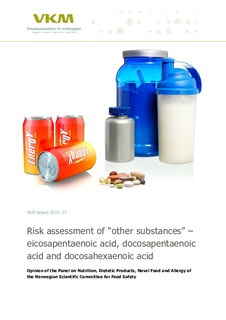| dc.contributor.author | Frøyland, Livar | |
| dc.contributor.author | Haugen, Margaretha | |
| dc.contributor.author | Holvik, Kristin | |
| dc.contributor.author | Løvik, Martinus | |
| dc.contributor.author | Strand, Tor A | |
| dc.contributor.author | Tell, Grethe S. | |
| dc.contributor.author | Vaktskjold, Arild | |
| dc.contributor.author | Iversen, Per Ole | |
| dc.coverage.spatial | Norway | nb_NO |
| dc.date.accessioned | 2018-04-27T12:32:24Z | |
| dc.date.available | 2018-04-27T12:32:24Z | |
| dc.date.created | 2017-10-19T10:42:26Z | |
| dc.date.issued | 2015 | |
| dc.identifier.isbn | 978-82-8259-182-9 | |
| dc.identifier.uri | http://hdl.handle.net/11250/2496402 | |
| dc.description.abstract | The Norwegian Scientific Committee for Food Safety (VKM) has, at the request of the Norwegian Food Safety Authority, assessed the risk of eicosapentaenoic acid (EPA), docosapentaenoic acid (DPA) and docosahexaenoic acid (DHA) in food supplements. VKM concludes that:
• The specified doses of 1500, 1750 or 1825 mg/day of EPA in food supplements are unlikely to cause adverse health effects in adults (≥18 years). Due to few studies in children and adolescents, no conclusion can be drawn for these groups for EPA.
• The specified doses of 1050 and 1290 mg/day of DHA in food supplements are unlikely to cause adverse health effects in the general population including children (≥10 years), adolescents and adults (≥18 years).
• No dosage of DPA in food supplements can be evaluated due to lack of data. It is emphasised that this risk assessment concerns the single fatty acids EPA, DPA or DHA separately and not mixtures of these as found in e.g. fish oil and cod liver oil. | nb_NO |
| dc.language.iso | eng | nb_NO |
| dc.publisher | Norwegian Committee for Food Safety (VKM) | nb_NO |
| dc.relation.ispartof | VKM Report | |
| dc.relation.ispartofseries | VKM Report; | |
| dc.relation.uri | https://vkm.no/download/18.645b840415d03a2fe8f26067/1502708618203/3ef862160c.pdf | |
| dc.rights | Navngivelse-Ikkekommersiell-DelPåSammeVilkår 4.0 Internasjonal | * |
| dc.rights.uri | http://creativecommons.org/licenses/by-nc-sa/4.0/deed.no | * |
| dc.subject | Adverse health effect | nb_NO |
| dc.subject | DHA | nb_NO |
| dc.subject | docosahexaenoic acid | nb_NO |
| dc.subject | docosapentaenoic acid | nb_NO |
| dc.subject | DPA | nb_NO |
| dc.subject | eicosapentaenoic acid | nb_NO |
| dc.subject | EPA | nb_NO |
| dc.subject | food supplement | nb_NO |
| dc.subject | n-3 LCPUFA | nb_NO |
| dc.subject | negative health effect | nb_NO |
| dc.subject | Norwegian Scientific Committee for Food Safety | nb_NO |
| dc.subject | omega-3 | nb_NO |
| dc.subject | other substances | nb_NO |
| dc.subject | risk assessment | nb_NO |
| dc.subject | VKM | nb_NO |
| dc.title | Risk assessment of “other substances” – eicosapentaenoic acid, docosapentaenoic acid and docosahexaenoic acid. Opinion of the Panel on Nutrition, Dietetic Products, Novel Food and Allergy of the Norwegian Scientific Committee for Food Safety | nb_NO |
| dc.type | Research report | nb_NO |
| dc.description.version | publishedVersion | nb_NO |
| dc.source.pagenumber | 65 | nb_NO |
| dc.source.issue | 27 | nb_NO |
| dc.identifier.cristin | 1505821 | |
| cristin.unitcode | 1991,0,0,0 | |
| cristin.unitname | Sykehuset Innlandet HF | |
| cristin.ispublished | true | |
| cristin.fulltext | original | |

